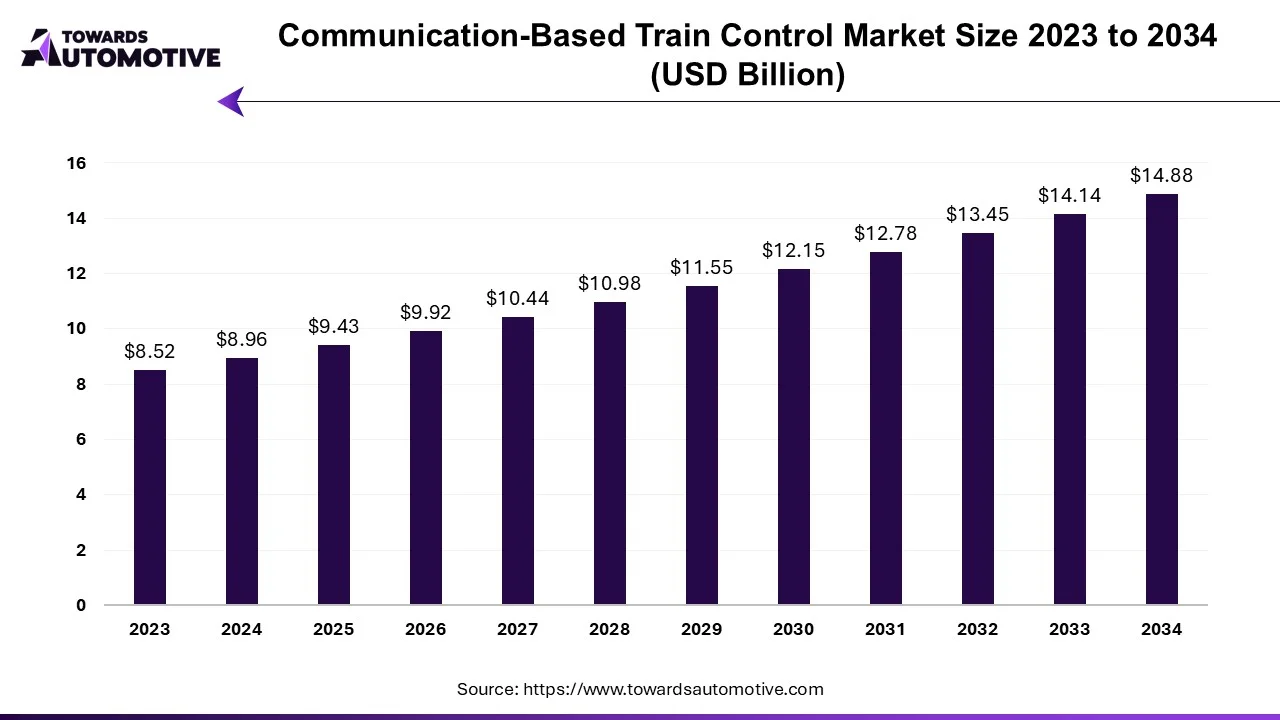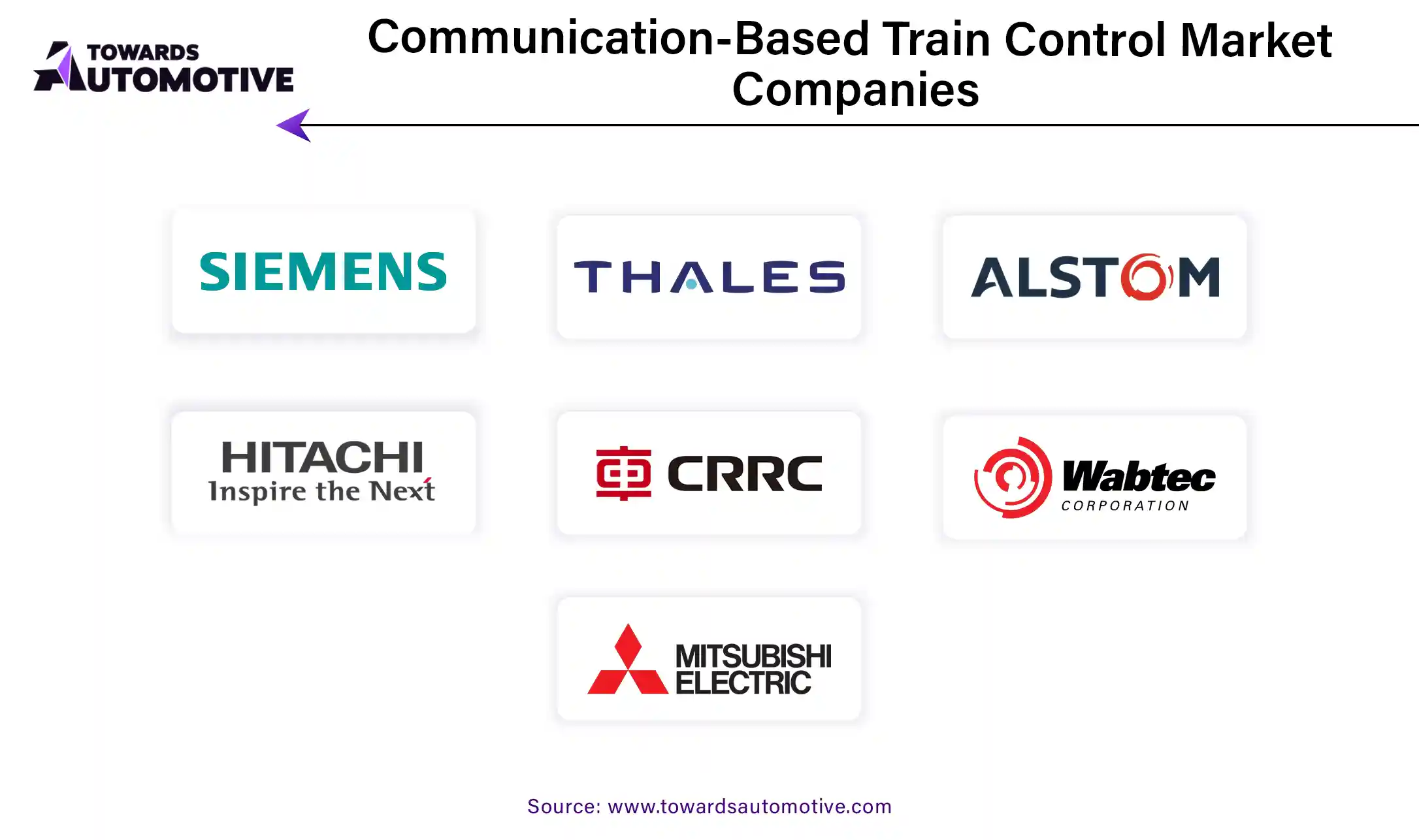Communication-Based Train Control Market Size and Growth Forecast
The communication-based train control market is forecasted to expand from USD 9.43 billion in 2025 to USD 14.88 billion by 2034, growing at a CAGR of 5.20% from 2025 to 2034.

Unlock Infinite Advantages: Subscribe to Annual Membership
This growth is driven by the increasing emphasis on rail safety, rising urbanization, and the need for efficient and reliable train control systems to meet the growing demand for public transportation.
Enhancing Rail Safety and Efficiency
Communication-based train control systems play a crucial role in enhancing rail safety, operational efficiency, and capacity utilization by providing precise train positioning, automated train protection, and real-time communication between trains and control centers. These systems leverage advanced signaling technologies, wireless communication protocols, and centralized control algorithms to enable safe and efficient train operations, reduce the risk of accidents, and optimize rail network performance in urban, suburban, and metro rail systems.
Key Components and Functions of CBTC Systems
- Train Control Subsystems: CBTC systems consist of onboard train control units, wayside signaling equipment, and central control systems that work together to ensure safe and efficient train operations. Onboard train control units equipped with GPS, inertial navigation systems, and radio transceivers provide continuous train positioning and communication with the central control system, while wayside signaling equipment, such as track circuits, balises, and radio beacons, transmit signals and commands to trains based on their location and movement.
- Wireless Communication Technologies: CBTC systems rely on wireless communication technologies, such as radio frequency (RF) communication, Wi-Fi, and cellular networks, to enable real-time data exchange between trains and control centers. These wireless communication links facilitate train-to-wayside communication, inter-train coordination, and remote control functionalities, allowing operators to monitor train movements, dispatch trains, and adjust traffic flow dynamically to ensure safety and efficiency in rail operations.
- Automatic Train Protection Features: CBTC systems incorporate automatic train protection (ATP) features, including speed supervision, collision avoidance, and route protection mechanisms, to prevent unsafe train movements and ensure compliance with operational constraints and safety rules. ATP functionalities use real-time train position data, speed profiles, and operational parameters to enforce safe braking distances, maintain safe separation between trains, and prevent unauthorized train movements, reducing the risk of accidents and improving overall system reliability.
Market Dynamics and Trends
- Urbanization and Public Transportation Expansion: The rapid urbanization and population growth in urban areas have led to increased demand for public transportation solutions, including metro, light rail, and commuter rail systems. As cities seek to address traffic congestion, reduce pollution, and improve mobility, investments in rail infrastructure and mass transit projects are on the rise, driving the adoption of communication-based train control systems to enhance rail safety, capacity, and reliability.
- Digitization and Connectivity: The digitization of rail systems and the integration of connected technologies are transforming the rail industry, enabling operators to monitor train operations, analyze performance data, and optimize service delivery in real-time. CBTC systems equipped with connectivity features, such as Internet of Things (IoT) sensors, cloud-based analytics, and predictive maintenance capabilities, offer operators greater visibility into rail operations, proactive maintenance insights, and data-driven decision-making tools to improve system efficiency and passenger experience.
- Interoperability and Standardization: Interoperability and standardization initiatives play a crucial role in the CBTC market, enabling seamless integration and compatibility between different train control systems, subsystems, and vendors. Standardized communication protocols, signaling interfaces, and interoperable equipment specifications facilitate interoperability between CBTC systems deployed by different rail operators and manufacturers, promoting system compatibility, scalability, and cost-effectiveness in rail projects worldwide.
- Emerging Technologies and Innovations: Emerging technologies such as artificial intelligence (AI), machine learning, and edge computing are driving innovation in CBTC systems, enabling predictive maintenance, autonomous train operation, and dynamic traffic management capabilities. Advanced CBTC solutions leverage AI algorithms to analyze train movement patterns, predict maintenance needs, and optimize train schedules in real-time, enhancing system reliability, efficiency, and passenger satisfaction in rail networks.
Global Trends and Market Outlook
- Asia-Pacific Leads in CBTC Adoption: Asia-Pacific leads the communication-based train control market in terms of adoption and market share, driven by the rapid urbanization, population growth, and investment in metro and urban rail projects in countries such as China, India, and Southeast Asian nations. The region's expanding rail infrastructure, government support for public transportation, and focus on rail safety and efficiency contribute to the widespread adoption of CBTC systems in urban transit networks.
- Europe and North America Witness Steady Growth: Europe and North America witness steady growth in the communication-based train control market, fueled by investments in rail modernization, capacity expansion, and safety enhancement initiatives. Major cities in these regions, including London, Paris, New York, and Toronto, are upgrading their rail systems with CBTC technology to improve service reliability, increase train frequencies, and enhance passenger safety and comfort, driving demand for advanced train control solutions.
Challenges and Opportunities
- Complexity of Deployment: The deployment of communication-based train control systems involves complex engineering challenges, including system integration, interoperability testing, and safety certification, which can lead to project delays and cost overruns. However, opportunities lie in developing standardized deployment frameworks, modular system architectures, and interoperability guidelines to streamline CBTC deployment, reduce implementation risks, and accelerate project timelines for rail operators and infrastructure developers.
- Cybersecurity Risks: The increasing connectivity and digitization of CBTC systems expose them to cybersecurity risks, including data breaches, network intrusions, and malicious attacks that could disrupt train operations and compromise passenger safety. To mitigate cybersecurity risks, rail operators and technology vendors need to implement robust cybersecurity measures, such as encryption protocols, intrusion detection systems, and security monitoring tools, to safeguard CBTC systems against cyber threats and ensure system integrity and resilience.

Key Players in the Communication-Based Train Control Market
The communication-based train control market comprises a diverse ecosystem of rail operators, infrastructure developers, technology vendors, and system integrators.
Some of the prominent players in the market include:
- Siemens AG
- Thales Group
- Alstom SA
- Bombardier Transportation
- Hitachi Rail Limited
- CRRC Corporation Limited
- Ansaldo STS
- Wabtec Corporation
- Mitsubishi Electric Corporation
- Hyundai Rotem Company
Market Segmentation and Regional Outlook
By Train Control System Type
- Radio-Based CBTC
- Signaling-Based CBTC
By Application
- Metro and Urban Rail
- Light Rail and Tram
- Commuter Rail and Mainline
By Region
- North America
- United States
- Canada
- Mexico
- Rest of North America
- Europe
- Germany
- United Kingdom
- France
- Italy
- Rest of Europe
- Asia-Pacific
- China
- Japan
- India
- Rest of Asia-Pacific
- Latin America
- Brazil
- Argentina
- Rest of Latin America
- Middle East and Africa
- South Africa
- Saudi Arabia
- UAE
- Rest of Middle East and Africa
Recent Developments in the Communication-Based Train Control Market
- In December 2023, Siemens Mobility announced the successful deployment of its latest CBTC solution, the Siemens Trainguard MT CBTC system, on a new metro line in a major Asian city. The Trainguard MT system offers advanced train control and signaling capabilities, enabling higher capacity, increased reliability, and enhanced safety on urban rail networks, catering to the growing demand for efficient and modern transportation systems in densely populated urban areas.
- In November 2023, Thales Group introduced its next-generation CBTC platform, the Thales SelTrac G8, featuring advanced communication and automation technologies. The SelTrac G8 system offers improved train positioning accuracy, faster data transmission rates, and enhanced cybersecurity features, providing operators with greater operational flexibility and reliability, while ensuring passenger safety and service quality on metro and light rail networks worldwide.
- In October 2023, Bombardier Transportation unveiled its latest CBTC signaling solution, the Bombardier CITYFLO 650, designed for urban rail networks in emerging markets. The CITYFLO 650 system offers scalable and modular architecture, seamless integration with existing infrastructure, and advanced predictive maintenance capabilities, enabling operators to optimize capacity, reduce operating costs, and improve passenger satisfaction on metro and commuter rail lines in rapidly growing cities.
- In September 2023, Alstom introduced its innovative CBTC solution, the Alstom Urbalis Evolution, tailored for high-density urban rail networks. The Urbalis Evolution system offers real-time train tracking, automatic speed regulation, and predictive maintenance features, enhancing operational efficiency, capacity, and safety on metro and light rail lines, while minimizing disruptions and improving the passenger experience in congested urban environments.
- In August 2023, Hitachi Rail announced the successful implementation of its CBTC technology, the Hitachi ATC-NS, on a major commuter rail network in a growing Asian metropolis. The ATC-NS system offers advanced train control and signaling functionalities, including automatic train operation, precise train positioning, and adaptive speed control, enabling operators to optimize network capacity, improve service reliability, and ensure passenger safety on busy commuter routes.

